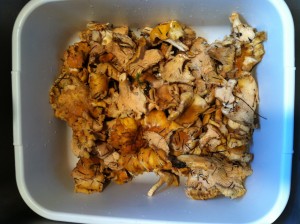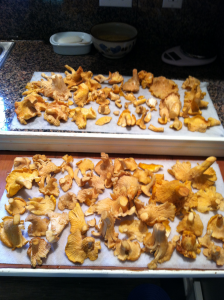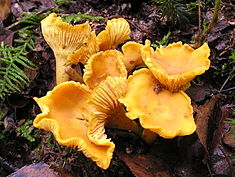
One damp day in November, I opened the door to pick up the mail and… lo and behold, there sat a fairly limp, slightly damp brown paper bag slumped against the door. So limp and damp that I had to fetch a washbasin to scoop it into and bring it to the kitchen.
What kind of goodies appeared out of nowhere?
Chanterelle mushrooms handpicked – and delivered – by our very special letter carrier. Chanterelles are orange or yellow, meaty and funnel-shaped. On the lower surface, underneath the smooth cap, it has gill-like ridges that run almost all the way down its stipe, which tapers down seamlessly from the cap. It has a fruity smell, reminiscent of apricots and a mildly peppery taste.

Though records of chanterelles being eaten date back to the 1500s, they first gained widespread recognition as a culinary delicacy with the spreading influence of French cuisine in the 1700s, where they began appearing in palace kitchens. For many years, they remained notable for being served at the tables of nobility.
Nowadays, the usage of chanterelles in the kitchen is common throughout Europe and North America. In 1836, the Swedish mycologist Elias Fries considered the chanterelle “as one of the most important and best edible mushrooms.”(Thank you, Wikipedia!)
The good news? Chanterelles are perfect to quickly saute in butter and freeze in small packets to use for the coming months.
The bad news? They are a real challenge to clean if they are hand harvested off the forest floor!
Many many thanks to our forager friend for sharing his bounty! Just one more reminder that local food is within reach where ever you live; and sometimes it’s the food of kings!

